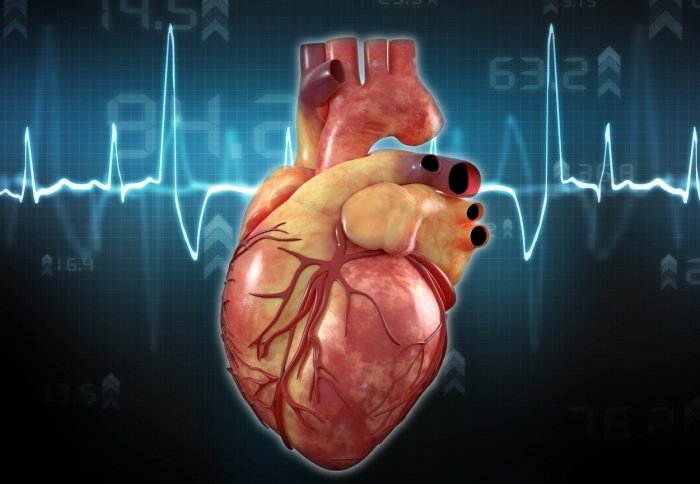Heart attack scars found to conduct electricity under right conditions

Scientists from Imperial have discovered that, contrary to previous understanding, heart scar tissue can conduct electricity following a heart attack.
These findings in mice, if confirmed in humans, would have major implications for heart attack survivors, and for patients with an irregular heartbeat known as atrial fibrillation.
An estimated 915,000 people in the UK today have had heart attacks, which deprive heart cells of oxygen, causing them to die and be replaced by scar tissue.
Scar tissue has important mechanical functions in maintaining the structure of damaged hearts, but when left untreated it effectively blocks the waves of electrical current needed for the heart to beat properly.
These waves of electricity roll in and out of the heart muscle – very much like waves on a beach. Scar tissue acts like a boulder on the edge of the beach, blocking the waves.
However, Imperial College London researchers have now found electrical activity in certain areas of the damaged tissue. To do this, they developed a new technique to put fluorescent proteins into scar cells that ‘light up’ when electrical waves are present.
If one can learn to control the function of these tubes so that electrical coupling across scars can be increased, it would reduce ‘boulder’ effects on electrical wave conduction and have significant implications for rehabilitating patients after a heart attack.
– Professor Peter Kohl
National Heart and Lung Institute
Senior author Professor Peter Kohl of Imperial’s National Heart & Lung Institute said: “This is a surprising but exciting finding, because we generally think of scar tissue as useless at best, and detrimental to normal organ function at worst. Of course, it is needed to provide mechanical strength, but scar tissue in the heart obstructs electrical waves needed to regulate the heartbeat. However, our research suggests that it may be possible to exploit them as passive conduits of electricity, which may allow us to render scar tissue electrically ‘invisible’.”
First author, Assistant Professor Alex Quinn from Dalhousie University, formerly of Imperial, adds: "These findings really turn our current understanding of the heart’s electrical activity on its head. While it had been suspected for some time, to finally show that scar tissue can indeed conduct electricity is a very exciting development, and one that may open the door to much needed improvements in treating many cardiac diseases.”
In the study, published in PNAS and funded by the European Research Council and British Heart Foundation, Professor Kohl and colleagues in Canada and the USA discovered that scar tissue – similar to that which is formed by heart attacks – can be electrically charged by the surviving heart muscle. They uncovered tiny membrane tunnels, known as nanotubes, between scar tissue and healthy heart cells, which might explain the electrical connection between the scar and surviving heart muscle.
Professor Kohl said: “If one can learn to control the function of these tubes so that electrical coupling across scars can be increased, it would reduce ‘boulder’ effects on electrical wave conduction and have significant implications for rehabilitating patients after a heart attack.”
Finding electrical conduction at the scar edge could also have important implications for patients with atrial fibrillation, which affects around a million people in the UK.
Some of these patients undergo interventions to cause local scarring, known as ‘ablation’. The idea is this interrupts stray electrical waves in the atria, and helps regulate the heart beat
However, the ablation scars become ineffective in two thirds of patients within months of the procedure, and the patients need to undergo the treatment again.
The team say that the current study may help to explain why ablation scars become ineffective. Again, if it were possible to control the electrical connections between healthy muscle and scar – in this case decreasing them – it would become possible to reduce the number of repeat interventions.
(Video caption: Part of the scar tissue (green) connects with the healthy tissue (blue) in a mouse's heart.)
Professor Kohl said: “Most research in this area focuses on rebuilding the heart by making new muscle to replace damaged tissue. However our findings suggest it might be more effective to work with nature’s repair mechanisms and tune up (after heart attack) or down (after ablation) the electrical connections that can form between the healthy and scarred tissue.”
The study was funded chiefly by the European Research Council Advanced Grant CardioNECT and a British Heart Foundation Senior Fellowship to Professor Kohl, who is now setting up the Institute for Experimental Cardiovascular Medicine at the University of Freiburg in Germany.
“Electrotonic coupling of excitable and nonexcitable cells in the heart revealed by optogenetics” by T. Alexander Quinn, Patrizia Camelliti, Eva A. Rog-Zielinska, Urszula Siedlecka, Tommaso Poggioli, Eileen T. O'Toole, Thomas Knöpfel, and Peter Kohl, published in PNAS, 20 December 2016.
Article supporters
Article text (excluding photos or graphics) © Imperial College London.
Photos and graphics subject to third party copyright used with permission or © Imperial College London.
Reporter
Caroline Brogan
Communications Division
